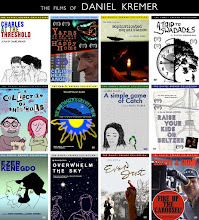For now, though, let's talk about the recent new entry in the pantheon of home theater history, and the capitalist Ferris wheel: one o' them new-fangled Blu-Rays. Oh no, the B word (that is, for you collectors who have invested untold sums in your standard-def DVD collections, like myself confessedly)! I have had many discussions with other video "enthusiasts" and connoisseurs heretofore about the concerns with the new format. One of the problems, it would appear, is contained within the name Blu-Ray itself. The picture looks awfully...oh, what's the word...you know...um, blue. The images on Blu-Ray transfers seem to mysteriously possess a coolish color-timing and a kind of uniform "frost" over the image. One need look no further than the uber savvy transfer-quality critics at DVDBeaver to make that observation. Furthermore, the skin-tones become a distraction on a great deal of these sampled Blu-Ray images. In addition to this, there would seem to be a uniform darkening of transfers, which in my opinion is suspect (although of course the images are sharper). Some noteworthy examples of this are in the reviews of the Blu-Rays of The Ipcress File and Batman Begins. And check out the actress Capucine in bed on a screen-capture from the Blu-Ray release of The Pink Panther. That is the most glaring and obvious example I could find of this "cool image" phenomenon. The only transfer I have seen so far that has countered (and bettered) the SD in correct color timing is the Blu-Ray of Fanny and Alexander. Once again, those Criterion boys and girls do fine work. There is warmth in the hues of these images as evident in the screen captures (particularly the skin-tones) that makes for a beautiful, balanced Blu-Ray transfer. They faltered a bit, however, on their DVD of Salo, or the 120 Days of Sodom.
A few months back, I had a Blu-Ray of my feature film A Trip to Swadades made. And what a fascinating experience it was! First of all, the visual style and look of the film are quite anomalous and counter to the "clean" images people are accustomed to seeing in today's film market. When filming Swadades, the super-16mm 7222 black-and-white Kodak stock was underexposed throughout shooting, and pushed in processing at the lab (pushing, for those who do not know, is compensating for lack of proper exposure during processing, heightening grain, giving it an aged feel and, as a side effect, distinguishing the blacks, whites and grays in black-and-white filmmaking in cases of wide-latitude for image exposure).
The compression and burning took all night long, and onto morning, beginning at noon the previous day and ending at 7 a.m. the next day. When the DVD came into my possession, I had an immediate look at it with great inquisitiveness. The hyper-grain naturally present in the image was readily apparent in the Blu-Ray. The grain popped in an extremely self-conscious way (I wanted people to be aware of a different look, but not to the extent that it would take them out of the film and distract/bother them). No cool problem, because of course there was no color to be had. Also, the titling in the opening credits sequence were not properly formatted prior to compression, and every bit of text was stretched tall and skinny. This is a peril that we only became aware of how to fix later and after the fact. HD compression requires special titling rendering...jot that down, any of you planning a Blu-Ray DVD compression in the near future! I am grateful I have that disc, but on the other hand, I am not eager to show the film in that form to anyone. First-time viewers are, in fact, forbidden from seeing the movie like this on their first go-round with the movie.
My discontent with outsourcing of home-theater formats is very apparent. Hey, I was bitter at first when VHS was being made obsolete by DVD, as I am now with the Blu-Ray outsourcing. However, whereas my initial DVD issues in the early 2000's were mostly bull-headed, I believe my Blu-Ray skepticism to warrant some merit. The image is certainly much sharper, but the transfers so far are a tad messy in their color temperature correction in terms of the cool hues. If you view me as an albatross, so be it. I am perfectly happy with my SD DVDs, and if they are made obsolete, I assure you, I will be among the last of the converts. Maybe by then, as what happened with SD DVDs, they will have mastered the process of color-timing Blu-Rays. Remember those first DVD releases from the late 90's? Ever wonder why companies are disposed to re-releasing those? Working out the kinks in a new system...


